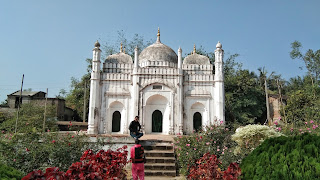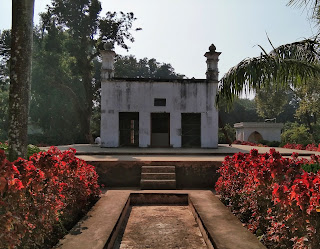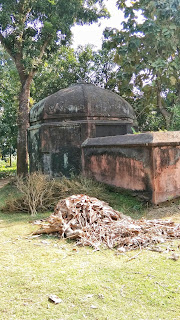A navaratna style devi temple was converted to a masjid by Shuja-ud-Din Mohammad Khan or Shuja Ud-Daula.
In most places in India, especially Bengal, you’ll find a Devi temple or a Shakti temple complex including one or more Shiva temples. Since Shiva is the consort of Shakti, they’re considered incomplete without each other. In Shaktism, Shiva is the masculine aspect of divinity, solely transcendent while Shakti is considered the dynamic feminine aspect of the Supreme divine. Hence a Shakti temple complex or a Devi temple complex will always include a Shiva temple.
The place currently known as Roshni Bagh was one such a Devi temple complex that contained one navaratna style mandir of devi which was the main temple, one house with the sacrificial alter, one Shiva temple and another older temple which was probably the smaller alternative Devi temple in case the number devotees were piled up too many.
After ascending the throne of Bengal, Nawab Shuja-ud-Din Mohammad Khan or Shuja-ud-Daula went on to Islamize Bengal.
He was an ultra-conservative Muslim but he less of a brute than others belonging to the ‘Aurangazeb School of Thought’, including Aurangzeb himself.
Shuja began an era of Islamic development in Bengal in the 1700s. What Islamic rulers understood by development was conversion of existing Hindu monuments to Islamic monuments or building mosques on Hindu temple sites after demolition of the said temples. There have even been examples of Temple parts or construction materials from Hindu monuments being used in Islamic buildings.
The easiest methods was to destroy the vigrahas inside the temples and convert the existing Hindu structures in to masjids.
The house containing sacrificial alter was converted to a tomb.
Roshni Bagh met the same fate, the vigraha(s) was destroyed and the main temple was converted to a masjid while the house containing the sacrificial alter was reserved for Shuja-ud-Daula tomb. The sacrificial alter was removed from the ground.
After Shuja’s death, the tomb was built where the sacrificial alter used to be.
The Eka-Linga Shiva Mandir that was salvaged by the Hindus upon the resistance of Bhaskar Pandit.
However, the Ek-Linga Shiva mandir was left to be as there was resistance from a certain influential pandit named Bhaskar Pandit. He convinced the Nawab to spare the temple. Since it was much in the corner, a low wall was built around it to keep it further out of sight and separate from the main complex which was now an Islamic complex known as Roshni Bagh. There is another temple that was left as it is just opposite to the EkaLinga Shiva Mandir.



